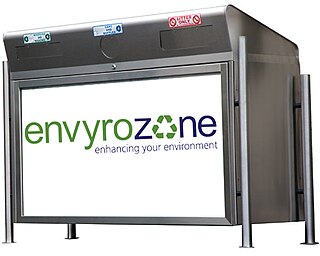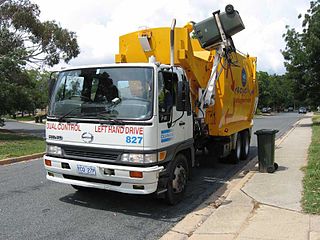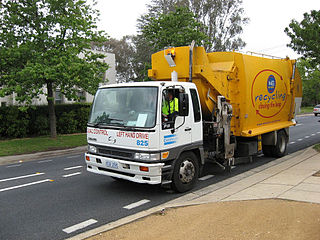
Recycling is the process of converting waste materials into new materials and objects. The recovery of energy from waste materials is often included in this concept. The recyclability of a material depends on its ability to reacquire the properties it had in its original state. It is an alternative to "conventional" waste disposal that can save material and help lower greenhouse gas emissions. It can also prevent the waste of potentially useful materials and reduce the consumption of fresh raw materials, reducing energy use, air pollution and water pollution.

A materials recovery facility, materials reclamation facility, materials recycling facility or Multi re-use facility is a specialized plant that receives, separates and prepares recyclable materials for marketing to end-user manufacturers. Generally, there are two different types: clean and dirty materials recovery facilities.

A recycling bin is a container used to hold recyclables before they are taken to recycling centers. Recycling bins exist in various sizes for use inside and outside homes, offices, and large public facilities. Separate containers are often provided for paper, tin or aluminum cans, and glass or plastic bottles, or may be commingled.

Municipal solid waste (MSW), commonly known as trash or garbage in the United States and rubbish in Britain, is a waste type consisting of everyday items that are discarded by the public. "Garbage" can also refer specifically to food waste, as in a garbage disposal; the two are sometimes collected separately. In the European Union, the semantic definition is 'mixed municipal waste,' given waste code 20 03 01 in the European Waste Catalog. Although the waste may originate from a number of sources that has nothing to do with a municipality, the traditional role of municipalities in collecting and managing these kinds of waste have produced the particular etymology 'municipal.'

Glass recycling is the processing of waste glass into usable products. Glass that is crushed or imploded and ready to be remelted is called cullet. There are two types of cullet: internal and external. Internal cullet is composed of defective products detected and rejected by a quality control process during the industrial process of glass manufacturing, transition phases of product changes and production offcuts. External cullet is waste glass that has been collected or reprocessed with the purpose of recycling. External cullet is classified as waste. The word "cullet", when used in the context of end-of-waste, will always refer to external cullet.

A waste container, also known as a dustbin, garbage can, and trash can is a type of container that is usually made out of metal or plastic. The words "rubbish", "basket" and "bin" are more common in British English usage; "trash" and "can" are more common in American English usage. "Garbage" may refer to food waste specifically or to municipal solid waste in general.

Kerbside collection or curbside collection is a service provided to households, typically in urban and suburban areas, of collecting and disposing of household waste and recyclables. It is usually accomplished by personnel using specially built vehicles to pick up household waste in containers that are acceptable to, or prescribed by, the municipality and are placed on the kerb.

Waste sorting is the process by which waste is separated into different elements. Waste sorting can occur manually at the household and collected through curbside collection schemes, or automatically separated in materials recovery facilities or mechanical biological treatment systems. Hand sorting was the first method used in the history of waste sorting. Until now this method is still used.

This article outlines the position and trends of recycling in Canada. Since the 1980s, most mid to large municipalities in most provinces have recycling programs, relying on curbside collection with either bins, boxes, or bags. These systems are not standardized, and the specific process differs for each province. Certain provinces have container-deposit systems in place for bottles, cans, and other beverage containers.
Recycling in the Netherlands is under the responsibility of local authorities. Different localities implement different systems. Municipalities all over the country publish a calendar, on a yearly basis, of the pickup dates and the addresses of the waste separation and recycling stations.

In 2015, 43.5% of the United Kingdom's municipal waste was recycled, composted or broken down by anaerobic digestion. The majority of recycling undertaken in the United Kingdom is done by statutory authorities, although commercial and industrial waste is chiefly processed by private companies. Local Authorities are responsible for the collection of municipal waste and operate contracts which are usually kerbside collection schemes. The Household Waste Recycling Act 2003 required local authorities in England to provide every household with a separate collection of at least two types of recyclable materials by 2010. Recycling policy is devolved to the administrations of Scotland, Northern Ireland and Wales who set their own targets, but all statistics are reported to Eurostat.

The waste management in Switzerland is based on the polluter pays principle. Bin bags are taxed with pay-per-bag fees in three quarters of the communes. The recycling rate doubled in 20 years due to this strategy. The recycling rate for municipal solid waste exceeds 50 percent.

The blue box recycling system (BBRS) was initially a waste management system used by Canadian municipalities to collect source separated household waste materials for the purpose of recycling. The first full-scale community wide BBRS was implemented in 1983 by the waste management contractor Ontario Total Recycling Systems Ltd. for the City of Kitchener, Ontario. The blue box recycling system was implemented as part of the city's waste management procedures. The blue box system and variations of it remain in place in hundreds of cities around the world.

Single-stream recycling refers to a system in which all paper fibers, plastics, metals, and other containers are mixed in a collection truck, instead of being sorted by the depositor into separate commodities and handled separately throughout the collection process. In single-stream, both the collection and processing systems are designed to handle this fully commingled mixture of recyclables, with materials being separated for reuse at a materials recovery facility.

Recycling in Japan, an aspect of waste management in Japan, is based on the Japanese Container and Packaging Recycling Law. Plastic, paper, PET bottles, aluminium and glass are collected and recycled. Japan’s country profile in Waste Atlas shows that in 2012 Recycling Rate was 20.8%.
Resource recovery is using wastes as an input material to create valuable products as new outputs. The aim is to reduce the amount of waste generated, thereby reducing the need for landfill space, and optimising the values created from waste. Resource recovery delays the need to use raw materials in the manufacturing process. Materials found in municipal solid waste, construction and demolition waste, commercial waste and industrial wastes can be used to recover resources for the manufacturing of new materials and products. Plastic, paper, aluminium, glass and metal are examples of where value can be found in waste.
Gypsum recycling is the process of turning gypsum waste into recycled gypsum, thereby generating a raw material that can replace virgin gypsum raw materials in the manufacturing of new products.

Recycling in Australia is a widespread, but not a comprehensive part of waste management in Australia. Recycling occurs through commingled kerbside recycling collections, drop-off programs, and various other schemes. Collection and management of household recycling typically falls to local councils, with private contractors collecting commercial and industrial recycling. In addition to local councils, legislation and overarching policies are implemented and managed by the state and federal governments.

New York City's waste management system is a refuse removal system primarily run by the New York City Department of Sanitation (DSNY). The department maintains the waste collection infrastructure and hires public and private contractors who remove the city's waste. This waste, created by New York City's population of more than eight million, can amount to more than ten thousand tons a day.

In Germany and Austria, the term yellow bag refers to a thin, yellowish transparent plastic bag, in which, in the context of local waste disposal, any waste made of plastic, metal or composite materials can be handed in. Depending on the agreement with the cities and municipalities, it may also be possible to use a 'yellow bin'. Yellow bags or yellow bins are part of the Dual System in the German waste management industry.



















